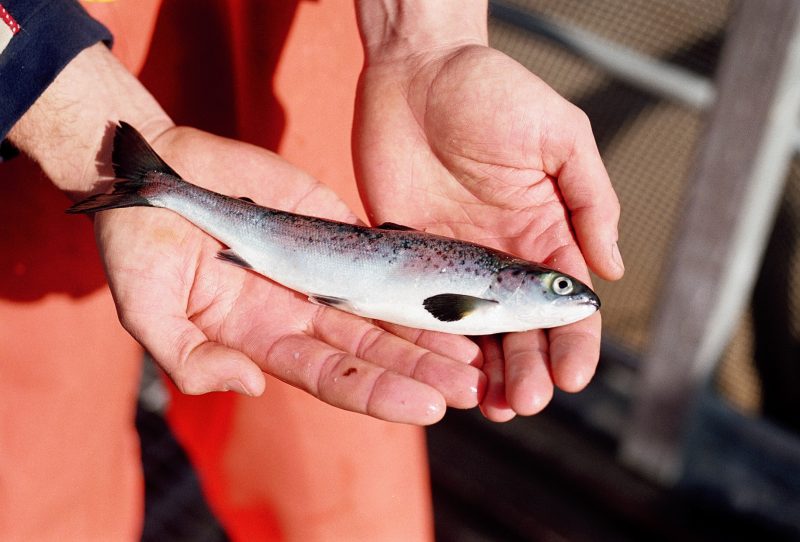Millions of Atlantic salmon introduced to B.C. streams since 1905
Atlantic salmon release programs on the West Coast were a collaboration between the provincial government and the Dominion Department of Fisheries
Source: Vancouver Sun – September 25, 2017 | Last Updated: September 25, 2017 6:24 PM PDT
More than eight million Atlantic salmon have been intentionally released into B.C. rivers and lakes, beginning more than a century ago.
With the support of the federal government, dozens of attempts were made to establish viable Atlantic salmon populations on the West Coast between 1905 and 1935.
The experiments are documented in studies of salmonid distribution dating to the 1950s and as recently as 2002, which concluded that no spawning populations had survived.
The escape last month of 165,000 Atlantic salmon from an ocean-based fish farm in the San Juan Islands has reignited concerns that escapees could out-compete Pacific salmon species or colonize B.C. rivers.
But history has shown that Atlantic salmon don’t feed well in the Pacific and have never established spawning populations outside their natural range despite transplant programs around the world.
“There are Pacific salmon in Lake Ontario, which is home for Atlantic salmon and guess who is winning? The Pacific species,” said Tony Farrell, a professor in the Faculty of Land and Food Systems at the University of B.C.
Early efforts to establish the East Coast native here may have been a response to pressure from anglers, who were keen to catch Atlantic salmon, which were considered superior to Pacific species, said Farrell.
The number of fish released in a year varied from as few as 1,200 in 1906 to as many as 1.1 million by 1928.
“At the time the Fraser River sockeye was in the midst of one of the biggest population crashes in history after the Hell’s Gate slide in 1913 that blocked spawners,” he said. “There were about a million (Atlantic salmon) released each year from 1923 to 1928.”
Atlantic salmon release programs on the West Coast were a collaboration between the provincial government and the Dominion Department of Fisheries, said Andrew Thomson, regional director for Fisheries and Oceans Canada (DFO).
“The conversation goes back to the late 1800s, when it was not uncommon to introduce fish to places all around the world and Atlantic salmon were deemed to be a prized game fish,” he said.
B.C. appears to have been the target of one of the world’s most intensive programs of Atlantic salmon introductions.
“Nearly 200 introductions were made into 52 different water bodies and a total of 13.9 million eggs, alevins, fry or smolts were introduced,” according to a 2017 report to the Organization for Economic Co-operation and Development (OECD).
The Cowichan River on Vancouver Island was repeatedly stocked beginning in 1905 with hundreds of thousands of Atlantic salmon in various early life stages. Eggs were sourced from hatcheries on the Atlantic coast of Canada, but also from Scotland, according to a UBC alien-species report. The report notes three credible reports of Atlantic salmon that may have been the product of local spawning being caught by anglers in the Cowichan River, but none since 1926.
Juvenile fish were also released into the Coquitlam River, Lillooet River, Harrison Lake, the Campbell River, Comox Lake, Horne Lake, Nanaimo Lake, Cowichan Lake and Koksilah River.
“None of these introductions was successful in terms of establishing runs of Atlantic salmon on the British Columbia coast,” reads the OECD report.
Foreign fin fish introduced to B.C. that still thrive today include Brown trout, Speckled Char, American Shad, Largemouth Bass, Smallmouth Bass and Yellow Perch.
“The DFO no longer promotes the introduction of new species into British Columbia and we have programs in place to monitor sightings of invasive species,” said Thomson.
The Atlantic Salmon Watch program is monitoring B.C. waters for escapees and signs of spawning.
“If we find Atlantic salmon in our river systems as a result of the recent escape we will go in and remove them, not because they present a significant threat, but if we have an opportunity to remove a foreign species, why wouldn’t we?” he said.
Of interest Alaska Hatchery Pink Salmon
